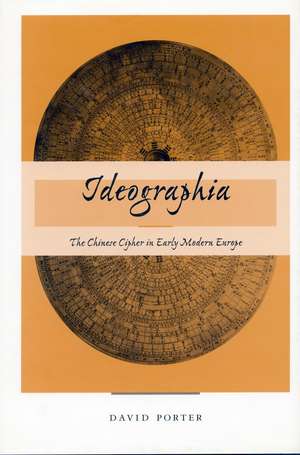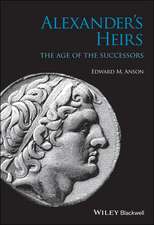Ideographia: The Chinese Cipher in Early Modern Europe
Autor David Porteren Limba Engleză Hardback – 30 iun 2002
From the first successful Jesuit mission in 1583 until the disastrous failure of the British trade embassy in 1816, China’s cultural practices transfixed the attention of Western philosophers, theologians, architects, artists, entrepreneurs, and social critics. The direct influences on European culture were many and profound, ranging from Chinese teahouses in European palace gardens to adaptations of Chinese plays for the popular stage, from calls for the restructuring of the civil service on the model of Chinese meritocracy to the espousal of Confucian precepts in the moral education of children.
More significant than even such readily visible gestures of imitation and appropriation, however, were the interpretive strategies that accompanied them: the processes by which Europeans translated the unfamiliar and often enigmatic artifacts of Chinese culture into familiar forms of meaning, thus engaging them in the emergent discourses of European modernity.
This book traces recurrent patterns in the European imaginative constructions of China through four illuminating spheres of encounter: linguistic, theological, aesthetic, and economic. How might we compare the perplexity of Europeans before the Chinese writing system with their experience of Chinese religious practice, trade policy, or porcelain design? The author shows how the remarkably consistent interpretive paradigms revealed through such comparisons suggest not only how historical circumstances condition and constrain responses to the foreign but also how an active engagement with the cipher of foreignness shapes the way a society comes to understand itself.
More significant than even such readily visible gestures of imitation and appropriation, however, were the interpretive strategies that accompanied them: the processes by which Europeans translated the unfamiliar and often enigmatic artifacts of Chinese culture into familiar forms of meaning, thus engaging them in the emergent discourses of European modernity.
This book traces recurrent patterns in the European imaginative constructions of China through four illuminating spheres of encounter: linguistic, theological, aesthetic, and economic. How might we compare the perplexity of Europeans before the Chinese writing system with their experience of Chinese religious practice, trade policy, or porcelain design? The author shows how the remarkably consistent interpretive paradigms revealed through such comparisons suggest not only how historical circumstances condition and constrain responses to the foreign but also how an active engagement with the cipher of foreignness shapes the way a society comes to understand itself.
Preț: 449.89 lei
Preț vechi: 555.42 lei
-19% Nou
Puncte Express: 675
Preț estimativ în valută:
86.11€ • 93.57$ • 72.38£
86.11€ • 93.57$ • 72.38£
Carte tipărită la comandă
Livrare economică 22 aprilie-06 mai
Preluare comenzi: 021 569.72.76
Specificații
ISBN-13: 9780804732031
ISBN-10: 0804732035
Pagini: 312
Dimensiuni: 152 x 229 x 28 mm
Greutate: 0.58 kg
Ediția:1
Editura: Stanford University Press
Colecția Stanford University Press
ISBN-10: 0804732035
Pagini: 312
Dimensiuni: 152 x 229 x 28 mm
Greutate: 0.58 kg
Ediția:1
Editura: Stanford University Press
Colecția Stanford University Press
Recenzii
"David Porter, in an intelligent and erudite book, examines four episodes of early modern European images of China that shaped European values and self-concepts. . . ." —International History Review
Notă biografică
David Porter is Assistant Professor of English and Comparative Literature at the University of Michigan. He is the editor of Internet Culture and Between Men and Feminism.
Textul de pe ultima copertă
“David Porter, in an intelligent and erudite book, examines four episodes of early modern European images of China that shaped European values and self-concepts. . . .” —International History Review
Descriere
From the first successful Jesuit mission to China in 1583, China's cultural practices transfixed the attention of Western philosophers, theologians, architects, artists, entrepreneurs, and social critics. This book traces recurrent patterns in the European imaginative constructions of China through four illuminating spheres of encounter: linguistic, theological, aesthetic, and economic.













